Abstract
This research paper presents an assessment of geohazards on Lefkas Island, Greece, using Geographic Information System (GIS) technology to map risk and enhance public awareness through an interactive web application. Natural hazards such as landslides, floods, wildfires, and desertification threaten both the safety of residents and the island’s tourism-dependent economy, particularly due to its seismic activity and Mediterranean climate. By combining the Sendai Framework for Disaster Risk Reduction with GIS capabilities, we created detailed hazard maps that visually represent areas of susceptibility and provide critical insights for local authorities and the public. The web application developed serves as a user-friendly platform for disseminating hazard information and educational resources, thus promoting community preparedness and resilience. The findings highlight the necessity for proactive land management strategies and community engagement in disaster risk reduction efforts. This study underscores GIS’s pivotal role in fostering informed decision making and enhancing the safety of Lefkas Island’s inhabitants and visitors in the face of environmental challenges.
1. Introduction
Natural hazards such as wildfires, floods, and landslides pose serious risks to human lives, infrastructure, and the environment—and evidence suggests that these events are becoming more frequent and intense. For this reason, there is a growing need to reduce community vulnerability and strengthen local resilience. In response, the United Nations adopted the Sendai Framework for Disaster Risk Reduction 2015–2030, which emphasizes understanding disaster risks, improving risk governance, investing in prevention, and strengthening disaster preparedness for more effective responses and recovery efforts [1].
The framework also highlights the importance of reducing vulnerability—an outcome shaped by both environmental and socioeconomic factors. Vulnerability reduction includes not only technical measures, such as building flood defenses or firebreaks, but also the ability of communities to respond to and recover from disasters. This involves integrating hazard assessments into planning processes, improving early warning systems, and promoting awareness and preparedness [2,3]. By addressing these factors, both the risk and the long-term impacts of disasters can be reduced.
Technological advances in recent years have made Geographic Information Systems (GIS) essential tools in disaster risk reduction. GIS allows researchers and decision makers to analyze spatial data, create hazard maps, and visualize areas at risk [4]. By combining multiple datasets—such as topography, land use, and rainfall—GIS supports models that identify the areas most vulnerable to specific hazards [5]. These hazard maps are valuable for local authorities and urban planners, helping them prioritize areas for emergency planning and guide development away from high-risk zones.
In addition to technical analysis, GIS tools are increasingly used for public education and engagement. Through web-based applications, hazard information can be shared in an interactive and easy-to-understand format. These tools allow users to explore maps, view real-time data, and better understand the risks in their area [6]. Examples like FEMA’s Hazus [7] and the European Copernicus Emergency Management Services [8] show how GIS platforms can help individuals and communities prepare more effectively [9]. Crowdsourced platforms, such as Ushahidi, also demonstrate how public input can improve situational awareness during disasters [10].
Lefkas (Lefkada) Island, located in the Ionian Sea in Western Greece, is well known for its natural beauty and as a tourist destination. However, its seismic activity, steep terrain, and Mediterranean climate make it vulnerable to several hazards, including landslides, floods, wildfires, and desertification. These hazards threaten both the safety of residents and the island’s economy, which heavily depends on tourism.
This paper presents a GIS-based analysis of major hazards affecting Lefkas Island, combined with the development of an interactive web application designed to make hazard information more accessible to the public. This effort is aligned with the goals of the Sendai Framework and aims to support local authorities, residents, and visitors by increasing awareness, promoting preparedness, and helping guide safer land-use decisions. By integrating spatial data with community-focused tools, this work contributes to building local resilience and supporting disaster risk reduction on the island.
2. Study Area
Lefkas Island (also known as Lefkada) is located in the Ionian Sea in Western Greece, between the islands of Corfu and Kefalonia. It is part of the Heptanese Islands and is the fourth largest in the group in terms of area (Figure 1). Lefkas lies very close to the mainland coast of Western Greece and is connected to it by a 50 m long floating drawbridge across a narrow channel.
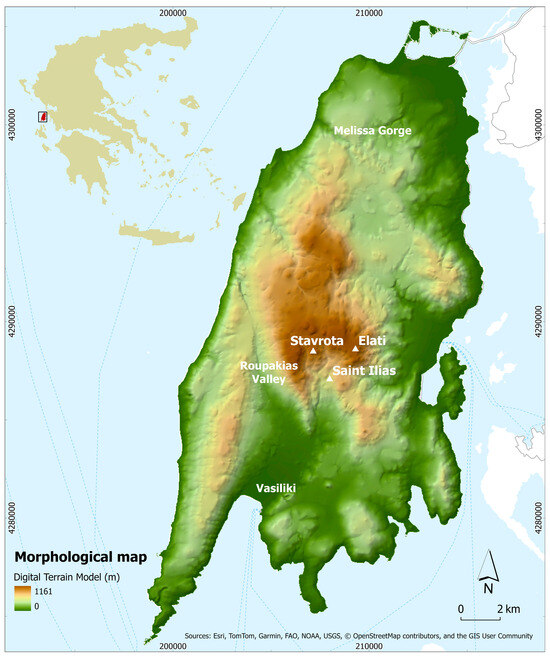
Figure 1.
Digital Terrain Model of Lefkas Island indicating the peaks, plains and deep valleys on the Island. The small map presents the geographic location of the island in Greece.
2.1. Morphology
The island is predominantly mountainous, with approximately 90% of its surface covered by steep terrain. The highest peaks are Stavrota (1182 m), Elati (1126 m), and Saint Ilias (1014 m). The largest lowland area is located in the south, in the Vasiliki region (Figure 1). The landscape also features deep V-shaped valleys, such as those in Roupakias and the Melissa Gorge, which are primarily the result of intense tectonic activity [11].
Using a Digital Terrain Model (DTM) with a 25 m ground resolution, provided by the National Cadastre & Mapping Agency S.A. (Attica, Greece), a shaded relief map was generated (Figure 1), which served as the base layer for the hazard maps.
As slope characteristics strongly influence hazard susceptibility, both a Morphological Slope Map and a Slope Aspect Map were created. The Morphological Slope Map shows that the island is mostly covered by mild slopes (5.1–15°), which make up 33.9% of the total area (Figure 2). Steep slopes greater than 25°, which are more vulnerable to landslides and erosion, occupy 20.94% of the island.
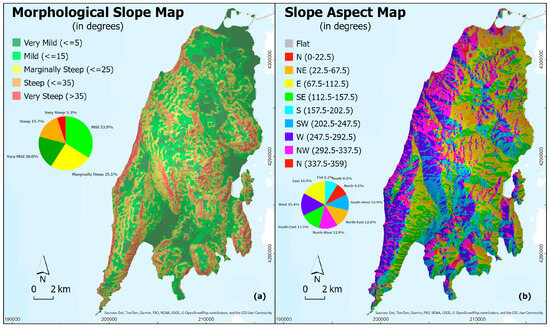
Figure 2.
(a) Morphological Slope Map of Lefkas Island and (b) Slope Aspect Map. Pie charts present the percentage of area occupied by the various categories.
Figure 2a uses a color-coded system to classify slope steepness following the method of Sikdar et al. (2004) [12]. The main part of Lefkas Island consists of very mild to mild slopes (53.92%), making it highly suitable for human activities, while steep and very steep areas (20.93%) require specialized approaches for land management and development. Specifically:
- Very Mild Slopes (<5°), shown in green, cover 20.0% of the island. These areas are mainly located in valleys and lowland regions, particularly in the northeastern and central parts of the island and are generally more suitable for development and agriculture.
- Mild Slopes (5–15°), displayed in light green, represent the largest portion at 33.9%. They are widely distributed across the island, especially in inland areas, forming a transitional zone between flat lands and hilly terrain.
- Marginally Steep Slopes (15–25°), colored yellow, occupy 25.1% of the land. These zones typically surround the hillier areas and appear in bands across mid-elevation regions, indicating moderate slope gradients.
- Steep Slopes (25–35°), marked in orange, cover 15.7% of the island. These are concentrated along ridges and elevated zones, particularly on the western and southern flanks, where terrain becomes significantly more rugged.
- Very Steep Slopes (>35°), shown in red, account for 5.3% of the area. These are found in isolated patches on sharp ridges and coastal escarpments, indicating the steepest and most erosion-prone parts of the island.
The Slope Aspect Map (Figure 2b) classifies terrain based on the direction that slopes face. East-facing slopes (22.5–157.5°) dominate the island, covering approximately 43% of the surface and receiving strong morning sunlight. West-facing slopes (202.5–337.5°) follow with 39.2%, aligning with regions more exposed to prevailing weather systems and frequent landslides along the western coastline. South-facing slopes (157.5–202.5°), covering 8.49%, experience higher solar radiation and tend to be drier, while north-facing slopes (337.5–22.5°), accounting for 9.15%, are generally cooler and moister. Flat areas are minimal (0.2%) and mainly located in coastal or lowland zones. These orientations influence microclimatic conditions such as moisture retention, exposure to prevailing winds, and vegetation growth, which are important for hazard modeling and land-use planning.
2.2. Climate—Hydrological Data
Lefkas lies within the Western Central Water District of Greece, one of the country’s rainiest regions. Coastal areas receive 800–1000 mm of rainfall annually, while precipitation in the plains can reach up to 1400 mm, and mountainous regions up to 1800 mm [13]. The island follows a typical Mediterranean climate, with most rainfall occurring from November to February and the driest months being July and August. Based on Gaussen’s Xerographic Index [14], the island’s climate ranges from mild to strong Mid-Mediterranean, depending on altitude.
Using rainfall data from local meteorological stations, a Precipitation Map was generated using the Thiessen polygon method (Figure 3). The average annual rainfall ranges from 845 mm to 918 mm, with the driest areas located in the southeast.
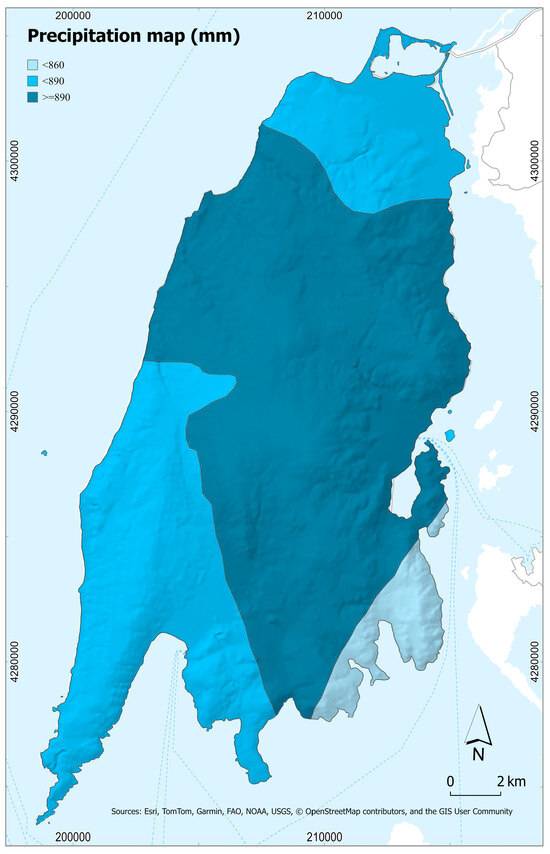
Figure 3.
Precipitation Map of Lefkas Island that was constructed with rainfall data from the meteorological stations across the region of interest using the Thiessen polygon methodology. The island experiences an average amount of precipitation of 845–918 mm, with the lowest amount occurring in the south-east part of the island.
The drainage network of the island (Figure 4) is denser in the southeast and reaches up to the 5th order, according to Strahler’s classification covering an area of 365 km2. Although the island has no lakes, its geology supports a major underground karst system, which supplies springs throughout the island. These water sources are used for drinking, irrigation, and limited industrial purposes. Annual water withdrawals total approximately 5.7 hm3, most of which is used for drinking water (3.5 hm3), followed by irrigation (2.1 hm3), with only small amounts for industrial (0.1 hm3) and livestock use (0.01 hm3) (Figure 4).
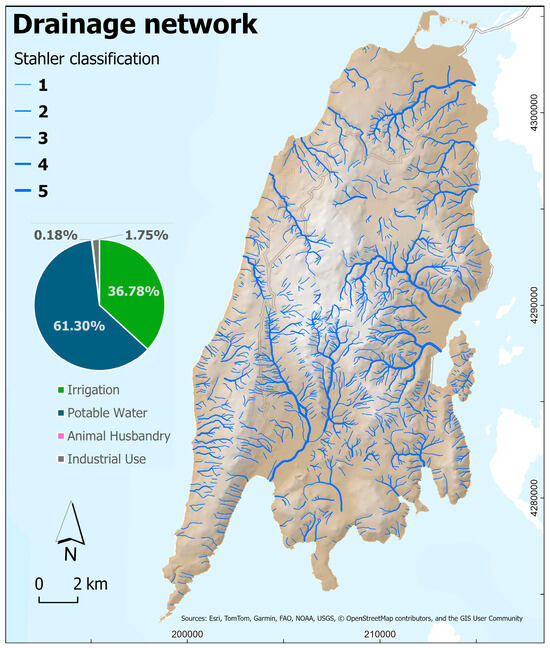
Figure 4.
Drainage network classification map of Lefkas Island according to Strahler. The chart shows the distribution of annual water withdrawals in the LAP Lefkados (EL0444) according to [15].
2.3. Geological Structure
Lefkas Island is made up of both alpine and post-alpine geological formations. The alpine formations include the Ionian Unit, which covers most of the island, and the Paxoi Unit, found mainly in the southwest. These formations consist of carbonate and clastic rocks dating from the Triassic to the Miocene periods [16].
The molasse formations include clastics, mainly marine sediments (marls, bioclastic igneous limestones, siltstones—cobblestones, sandstones) of Lower–Middle Miocene age which superimpose the folded formations of the Ionian Unit that makes up the main body of the island.
On the contrary, in the western part, where the Paxos Unit is developed, the isochronous sediments of the molasse formations constitute the lower parts of the clastic sheet series of the said unit. Post-alpine formations include Neogene clastic sediments with lacustrine or terrestrial characters, as well as Quaternary coastal, terrestrial, or lacustrine deposits [16] (Figure 5).
Lefkas Island is in the western part of the external island arc of the Hellenides, where the geotectonic framework is determined by the termination of the subduction zone of the Eastern Mediterranean crust under the Aegean, located west of the island [17]. Two main groups of active faults in relation to their direction (Figure 5) can be distinguished: (a) Faults with NW-SE to N-S direction, that are parallel or sub-parallel to the axis of the trench and (b) Faults with an almost NW-SE to WNW-ESE direction, that are parallel or sub-parallel to the Sperchios–Amvrakikos rift zone that passes north of Lefkas Island [18].
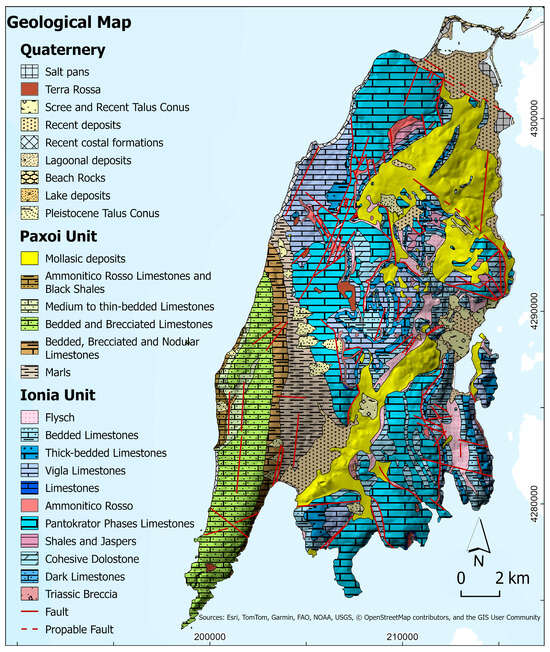
Figure 5.
Geological Map of Lefkas Island (modified from EAGME [19]).
Lastly, according to their hydrolithological behavior, the geological formations can be grouped into three categories: (a) High Permeable formations, which occupy 61.6% of the area and consist of Carbonate rocks and Triassic breccia, (b) Low Permeable formations that make up 33% of the area and consist of recent Alluvium, Scree and Talus Conus and Molassic Formations and (c) Impermeable formations occupying only 5.5% of the area, and consist of marly and slate formations, flysch and Ammonitico Rosso (Figure 6).
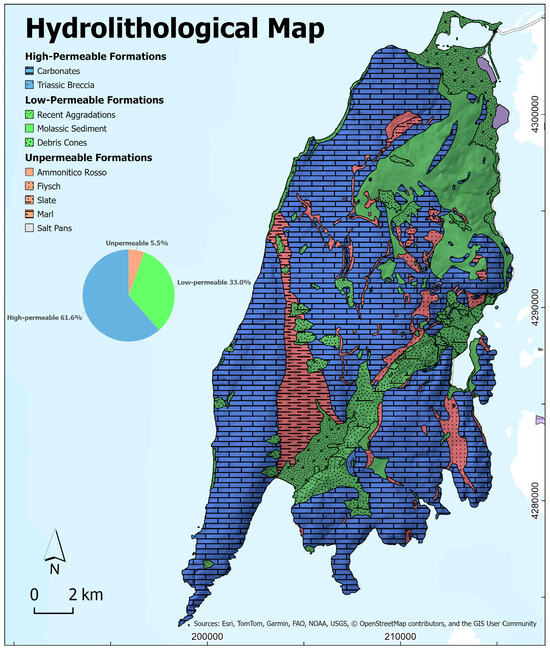
Figure 6.
Hydrolithological Map of Lefkas Island (modified from EAGME [19]).
2.4. Land Use/Cover
According to Corine 2018 data (Figure 7), Lefkas is dominated by three main land uses: sclerophyllous vegetation (24.36%), land principally occupied for agriculture, with significant areas of natural vegetation (23.35%), and olive groves (17.20%).
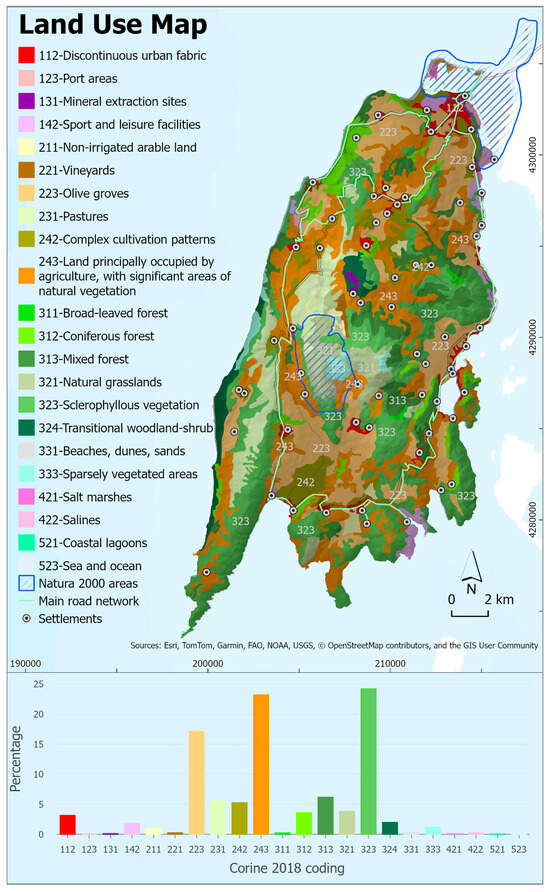
Figure 7.
Land-Use Map of Lefkas Island. Diagram presents the percentage of area occupied by the various Corine 2018 land uses.
The island also contains two Natura 2000 Special Protection Areas (SPAs) (Figure 7): the Lefkada Strait Lagoons (Palionis–Avlimon) and the Lefkada Salt Flats (GR2240001) in the north and the Grass Area of Lefkada (GR2240002) in the center. These zones are ecologically sensitive and may be more vulnerable to certain hazards.
The road network is relatively well developed (Figure 7), including main roads, provincial roads, and dirt tracks that connect all the settlements. This infrastructure, while improving accessibility, also increases exposure to hazards such as landslides and wildfires.
In the following sections, four natural hazards are examined in detail—landslides, floods, wildfires, and desertification—all of which pose significant threats to Lefkas Island’s environment and local communities. Although seismic activity is the dominant hazard in the region, it is already well recognized by the local population. For this reason, our focus shifts to other major hazards that may receive less attention but still present serious risks. By assessing these hazards, this study aims to provide practical insights and support strategies that can help reduce their impact and improve the island’s overall resilience.
3. Materials and Methods
The methodology used in this study followed two main steps, as shown in the workflow diagram (Figure 8):
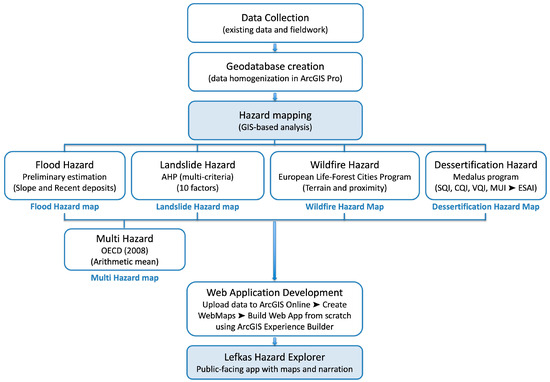
Figure 8.
Workflow diagram of the research process followed in this study. The analysis begins with data collection and geodatabase creation, followed by GIS-based hazard mapping for floods, landslides, wildfires, and desertification. The resulting maps are then integrated into an interactive web application, leading to the publicly accessible Lefkas Island Hazard Explorer application.
3.1. Step 1. GIS Analysis
In the first step, all necessary data—collected from previous research and fieldwork—were compiled into a structured geodatabase. The data were standardized and imported into ArcGIS Pro [20], chosen for its robust desktop and online capabilities and the authors’ familiarity with the platform.
For each hazard examined, specific variables were selected based on their relevance and established practices in the Hellenic area. These variables were processed and classified according to their contribution to hazard susceptibility, using methods tailored to each hazard type:
- Flood hazard: A preliminary assessment was carried out using morphological slope and geological data. Areas with low gradients and recent alluvial deposits were identified as more likely to experience flooding. This simplified approach was used due to the limited history of flood events on the island.
- Landslide hazard: The Analytical Hierarchy Process (AHP) was applied—a widely used method for evaluating multiple criteria by assigning relative weights based on pairwise comparisons. This method allowed for a structured combination of different factors, such as slope, lithology, and land use, to estimate susceptibility to landslides [21].
- Wildfire hazard: The method was based on the Guide for Drafting an Action Plan for the Prevention of Forest Fires, developed as part of the LIFE–Forest Cities program, drawn up in the framework of the European LIFE—Environment Program entitled “Local Authorities for Forest Fire Prevention” [22]. Parameters such as slope, land use, slope orientation, and proximity to roads, settlements, and power lines were included and weighted accordingly.
- Desertification hazard: The assessment followed the MEDALUS framework [23], which evaluates environmentally sensitive areas based on four indices: soil quality, climate quality, vegetation quality, and land management.
Each dataset was spatially analyzed and normalized in ArcGIS Pro, leading to the creation of detailed hazard maps for each type of hazard.
After generating individual hazard maps, a multi-hazard analysis was also conducted. This step involved combining the four hazard layers to highlight areas affected by more than one hazard following the methodology described by OECD 2008 [24]. The resulting map helps identify locations with cumulative hazard exposure and provides a broader perspective for spatial planning and disaster preparedness.
3.2. Step 2. Public Engagement Through a Web Application
To support community awareness and improve accessibility to hazard information, an interactive web application was developed using the ArcGIS Experience Builder platform [25].
First, the individual hazard maps were published on the ArcGIS Online platform [26], as web maps. Instead of using a ready-made template, a custom experience was built from scratch using Experience Builder to allow greater flexibility and control over the interface.
The web application was designed to maximize accessibility, user engagement, and the effective dissemination of critical information. The design and functionality choices were guided by the following key considerations:
- User-Centric Design: The app is designed with a user-friendly interface to ensure accessibility for a broad audience, including individuals with varying levels of technical expertise. The intuitive navigation and clear visual elements help users easily find and understand the information they need.
- Interactive Mapping: Leveraging the capabilities of ArcGIS, the app features interactive maps that allow users to visualize hazard data geographically. This spatial representation helps users comprehend the potential impact areas and the geographic distribution of various hazards.
- Comprehensive Information Layers: Multiple layers of information are available, allowing users to toggle between different types of hazards and related data. This layered approach enables a comprehensive understanding of the hazards and facilitates informed decision making.
- Responsive Design: Although ArcGIS Experience Builder provides tools to create responsive apps, ensuring compatibility across various devices, for the scope of the present paper only the desktop version is developed.
- Educational Resources: In addition to hazard data, the app provides educational resources to help users understand the nature of the hazards and recommended safety measures. This dual focus on information and education empowers users to take proactive steps in hazard preparedness.
By combining spatial analysis with an engaging digital platform, this two-part approach aims to support both scientific understanding and public communication of natural hazards on Lefkas Island.
4. Hazards Analysis
In this section, we examine the four major geohazards affecting Lefkas Island—floods, landslides, wildfires, and desertification—using GIS-based methods adapted to each hazard type, as mentioned in the previous section. The aim is to investigate whether, beyond the well-known seismic hazard, other environmental risks are also significant for the island. By identifying spatial patterns and contributing factors, the analysis supports efforts to inform both residents and visitors about potential risks. In addition, this study attempts to generate a Multi-Hazard Map to highlight areas with overlapping threats, providing a foundation for more targeted risk management and land-use planning.
4.1. Preliminary Flood Hazard Assessment
According to the National Environment Agency [27], no officially recorded flood events causing damage exist for Lefkas Island. However, local news sources report flooding incidents in the Vasiliki area on 16 November 2017, 6 May 2018, and 18 September 2020, indicating that localized events do occur.
To provide a preliminary assessment of flood hazard on the island, we combined two spatial parameters in a GIS environment. The first is morphological slope, categorized as above or below 2°, based on the principle that flatter areas are more prone to surface water accumulation due to reduced flow velocity. The second is geological formations, specifically the presence of recent deposits such as alluvial and fluvial sediments, which typically accumulate in flood-prone areas.
These criteria were used to assign hazard levels: areas with both low slopes and recent deposits were given the highest score (2); areas lacking one or both of these conditions received a lower score (0); and transitional areas—where recent deposits exist on steeper slopes—were assigned an intermediate value (1).
The resulting Flood Hazard Map (Figure 9) shows that, overall, flood susceptibility is low across most of the island. However, localized medium- to high-hazard zones appear in four key areas: Lefkada city (north), Vasiliki (south), Nidri (east), and Karia (central). These areas align with the island’s main residential and tourist centers, where population density and infrastructure development increase vulnerability. Although the hazard may not be extreme in physical terms, the exposure of people and assets elevates the level of risk, underlining the need for focused flood mitigation and land-use planning in these regions.
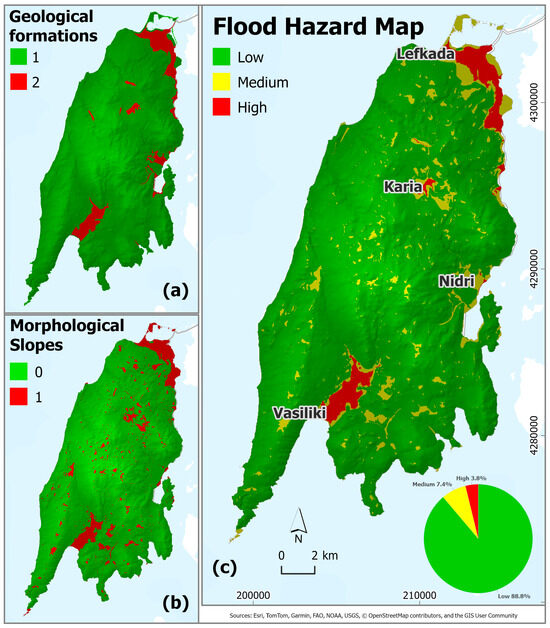
Figure 9.
Spatial distribution of parameters used to obtain Flood Hazard Map: Recent deposits (a) and morphological slopes (b) in 25 m resolution. The Flood Hazard Map of Lefkas Island (c) presents mainly areas with low hazard, where medium- and high-hazard zones cover Lefkada, Vasiliki, Karia, and Nidri areas.
4.2. Landslide Hazard Assessment
Landslides refer to the downward movement of rock, soil, or debris along a slope under the influence of gravity. These events can be triggered by natural causes, such as earthquakes and heavy rainfall, or by human activities, like deforestation or poorly constructed infrastructure. Landslides may occur gradually with minimal damage, or suddenly with severe consequences, including destruction of property and loss of life.
On Lefkas Island, landslides frequently occur on steep, remote slopes, particularly along the western coastline. Although official records are limited, event data were collected from local news sources [28], the “LAERTIS”—Innovative Operational Risk Management System in the Region of the Ionian Islands”, conducted by the Department of Geology and Geoenvironment of the National and Kapodistrian University of Athens research project [29], and other scientific studies [30,31]. These records are shown in Figure 10.
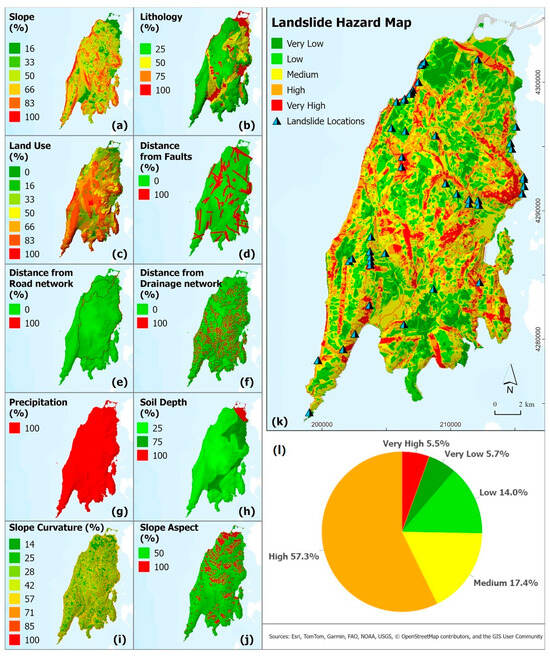
Figure 10.
Spatial distribution of normalized parameters used (a–k). The Landslide Hazard Map of Lefkas Island (l) indicates that the island falls under medium- to high-hazard categories. The map also marks the locations of past landslide events.
To assess landslide hazard, we applied the Analytical Hierarchy Process (AHP), a widely used multi-criteria decision-making method [21]. The process began by identifying ten relevant factors influencing landslide susceptibility on the island. Each factor was ranked based on its contribution to landslide risk, using the Reverse Ranking Method (where 1 = least influence, 10 = highest), as shown in Table 1. The weight of each factor was based on a review of established methodologies and existing studies conducted in similar geological settings across Greece, e.g., [32,33]. A consistency ratio (CR) of 0.0997 confirmed the reliability of the comparisons.

Table 1.
Pairwise comparison matrix used in the multi-criteria analysis for landslide susceptibility assessment. A: slope, B: lithology, C: land use, D: distance from faults, E: distance from roads, F: distance from drainage network, G: precipitation, H: soil depth, I: curvature, and K: slope aspect. The numerical values in each cell indicate the degree of preference between the corresponding factors. The final column presents the calculated weights for each factor, along with the consistency ratio (CR) of the matrix.

Table 2.
Parameter ranking used to obtain the Landslide Hazard Map.
- Slope: Susceptibility increases with slope steepness. However, on very steep slopes, greater than 45°, formations that are cohesive and rocky can ensure slope stability in terms of sliding but are vulnerable to collapsing. Slopes between 16 and 30° are most prone to landslides [32]. The steepest slopes (>35°) are concentrated in the southern part of the island.
- Lithology: According to [33], the landslide susceptibility of Greece can be divided into three zones—western, central, and eastern—based on the general geotechnical behavior of dominant geological formations. Lefkas Island, located in Western Greece, falls within the zone considered most prone to landslides. This elevated risk is linked to the lithological composition and structural characteristics of the region. The most vulnerable formations are loose, thin Quaternary deposits, which are highly susceptible to sliding. To a lesser extent, limestone and flysch formations also contribute to slope instability, primarily through rockfalls.
- Distance From Faults: Landslides are more frequent near active fault zones, which are widespread on the island.
- Land Use: Vegetation helps stabilize slopes. In Lefkas, only approximately one-third of the surface is well vegetated, making much of the island more vulnerable.
- Distance From the Road Network: Proximity to roads increases landslide risk due to slope modifications, poor drainage, and excavation. Although all settlements on Lefkas Island are connected by roads, the main road network consists primarily of a single route that encircles the island.
- Distance From the Drainage Network: Areas near rivers or streams are more prone to erosion, especially during heavy rainfall. Lefkas has a well-developed drainage network (Figure 4) covering most of the island.
- Precipitation: The island receives between 845 and 918 mm of annual rainfall, which can saturate soils and trigger slope instability.
- Soil Depth: Deeper soils are generally more prone to failure. Lefkas has mostly shallow soils, with deeper layers found in the north.
- Slope Curvature: Soils found on concave slopes are generally more prone to landslides because these landforms tend to accumulate and retain rainfall, increasing soil saturation and instability. In contrast, convex slopes are less likely to retain water and may also indicate the presence of underlying bedrock, which contributes to slope stability. On Lefkas Island, areas with high landslide risk due to slope curvature are limited and scattered across the island.
- Slope Aspect: Slopes that receive more sunlight tend to retain less soil moisture, which generally reduces the likelihood of landslides. In Greece, east- to southeast-facing slopes are typically warmer and more sun exposed, resulting in drier conditions that are less favorable for slope failures [34]. Lefkas Island is characterized mainly by north- to northwest-facing slopes, receiving less sunlight and retain more moisture, making them more susceptible to landslides.
Although seismic activity is a known landslide trigger—particularly in tectonically active regions like Lefkas ([35,36])—this factor was excluded due to the lack of spatially detailed seismic acceleration data at a resolution appropriate for island-scale modeling. While this omission reflects a data limitation, it is acknowledged as a key constraint of the current model.
Based on the AHP results, the Landslide Hazard Map (Figure 10) shows that most of Lefkas Island falls under medium- to high-hazard categories. Medium-hazard areas are spread across the island, while high- and very-high-hazard zones are concentrated in the central part, and along the eastern and western coastal slopes. Notably, most historical landslides align with these zones (Figure 11), supporting the accuracy of the model.
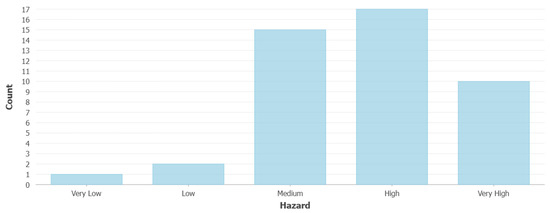
Figure 11.
Distribution of historical landslide events across hazard categories according to the Landslide Hazard Map. Most events fall within the medium- to very-high-hazard hazard zones, supporting the spatial reliability of the susceptibility model.
This assessment highlighted areas where slope failures are more likely and points to the need for preventive measures, such as slope stabilization, drainage improvements, and land-use restrictions in high-risk zones. Future versions of this model should incorporate dynamic triggers, including seismic parameters and rainfall thresholds, to enhance realism and predictive capability.
4.3. Wildfire Hazard Assessment
Wildfires pose a significant threat to Greece’s natural environment. Due to repeated fire events, approximately 10% of the country’s land has been transformed into barren, rocky terrain. Between 1983 and 2008, a total of 38,085 forest fire incidents were recorded, burning approximately 13.6 million hectares across the country. The Peloponnese accounted for the largest share of these events (27%), while the Ionian Islands, including Lefkas, experienced the lowest share (4%) [37]. Nationally, the areas affected were primarily forests (78.8%), followed by agricultural land (21.2%), emphasizing the critical role wildfires play in the degradation of Greece’s ecosystems, which recover only slowly [37].
On Lefkas Island, wildfire outbreaks are relatively rare, averaging approximately five incidents per year, but the island shows a 7% rate of fire recurrence, suggesting certain locations may be prone to repeated ignition [37]. Figure 12 presents annual burned areas on the island, based on data from the National Observatory of Athens [38], supplemented by smaller events reported in local media [28].
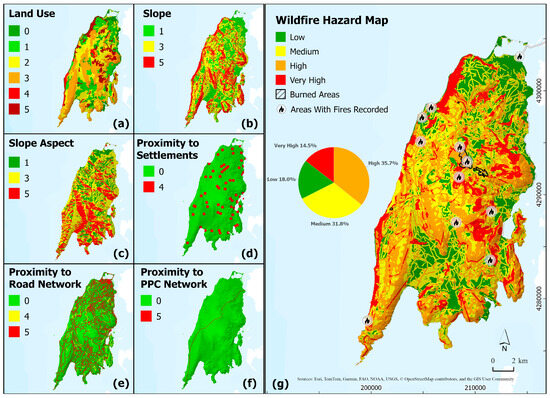
Figure 12.
Spatial distribution of the normalized parameters used (a–f). The Wildfire Hazard Map of Lefkas Island (g) shows that most areas on the island have high- to very-high-hazard levels. The map also marks the locations of past fire events.
To assess wildfire hazard across the island, we applied a model based on six spatial parameters, excluding short-term meteorological factors or climate change effects, in order to focus on baseline spatial vulnerability [22]. Each parameter was rated on a scale of 0 to 5, with higher scores indicating greater hazard, and weighted based on its relative contribution to wildfire risk (Table 3, Figure 12):

Table 3.
Parameter ranking used to obtain the Wildfire Hazard Map.
- Slope: Steeper slopes accelerate fire spread, so areas with gradients over 40% were assigned the highest hazard values. Lefkas western coasts are almost entirely areas with high-hazard values.
- Land Use: Land cover was evaluated using an adapted version of the Golden Gate National Recreation Area Fire Management Plan in the USA (California) [39], modified for Greek conditions. The model assigns 65% weight to natural and 35% to human-related factors. Forested areas were classified as the most vulnerable.
- Slope Aspect: Southeast- and southwest-facing slopes receive more sunlight and retain less moisture, making them more susceptible to fire outbreaks [34].
- Distance from Settlements: Zones within 400 m of settlements were considered high-hazard areas, as human activity increases the likelihood of fire ignition.
- Distance from the Road Network: Areas within 50 m of roads, especially paved ones, were assigned higher hazard values due to increased accessibility and the presence of potential fire-starting activities. Lefkas has a road network that spans nearly the entire island.
- Distance from the Public Power Corporation (PPC): A 30 m buffer around the PPC network was considered a high-risk zone. On Lefkas, the PPC line runs across the island from the southwest to northeast, forming a continuous hazard corridor.
Based on this analysis, the Wildfire Hazard Map indicates that a substantial portion of Lefkas Island is classified as high or very high hazard, with 35.7% of the island falling into the high category. Notably, the locations of past wildfire events correlate strongly with the mapped high- and very-high-hazard zones (Figure 13), which supports the reliability of the model. In addition, the recorded burned areas are predominantly located within medium- to high-hazard zones, further confirming the spatial accuracy and predictive value of the hazard classification.
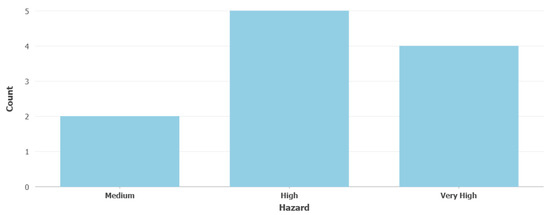
Figure 13.
Distribution of historical wildfire events across hazard categories according to the Wildfire Hazard Map. Most events fall within the high- to very-high-hazard zones, supporting the spatial reliability of the susceptibility model.
This assessment highlighted areas where preventive strategies, such as vegetation management, infrastructure monitoring, and firebreaks, should be prioritized. Future versions of this model should incorporate dynamic factors such as weather conditions, seasonal vegetation changes, or long-term climate trends, all of which strongly influence wildfire behavior—particularly in Mediterranean environments.
4.4. Desertification Hazard Assessment
Desertification, as defined by the United Nations Convention to Combat Desertification (UNCCD) [40], refers to the degradation of land in arid, semi-arid, and dry sub-humid areas, where the ratio of annual precipitation to potential evapotranspiration falls between 0.05 and 0.65. This degradation results from various natural processes and human activities that reduce the productivity and ecological balance of affected areas.
The current assessment of desertification on Lefkas Island follows the MEDALUS framework [31], which is based on static environmental parameters. While this method provides a useful spatial overview of land sensitivity, recent research highlights the potential of integrating dynamic, satellite-based indicators to improve the accuracy and responsiveness of land degradation models. For example, Sartor et al. (2024) [41] illustrate how deep learning methods applied to Sentinel-1 and Sentinel-2 data can track vegetation loss in near real-time, while Albamonte et al. (2025) [42] demonstrate the benefits of combining semantic and contextual data layers for remote environmental monitoring. Similarly, Darnkachatarn and Kajitani (2024) [43] show the effectiveness of long-term satellite-based land-use analysis in understanding flood-related landscape transformation, a method which could also be applied to desertification dynamics.
These approaches underline the value of combining spatial and temporal data to identify ecological shifts that may not be visible through static models alone. Therefore, while this study offers a baseline spatial analysis, future work should explore the use of time-series satellite data and vegetation indices to support more dynamic, long-term desertification monitoring.
In line with the approach used in this study, the MEDALUS methodology requires the evaluation of four main indices to produce the Desertification Hazard Map for Lefkas Island:
4.4.1. The Soil Quality Index (SQI)
The Soil Quality Index (SQI) evaluates how suitable soils are for supporting vegetation and resisting degradation. It is calculated as the geometric mean of six key factors: granulometric composition, parent material, coarse material content, soil depth, slope inclination, and hydromorphy. The formula used is:
SQI = (Granulometric Composition × Slope Inclination × Parent Rock × Soil Depth × Coarse Material Content × Hydromorphy)^(1/6)
Each of these parameters reflects a critical characteristic of soil performance. Using the geometric mean allows for balanced integration of the components, reducing the influence of any single extreme value on the final result.
Based on the calculated SQI, land is classified into three categories:
- High quality: SQI < 1.13;
- Medium quality: SQI between 1.13 and 1.45;
- Low quality: SQI > 1.45.
For Lefkas Island, the soil conditions vary across the parameters (Table 4, Figure 14). The granulometric composition is generally favorable, with most areas receiving the best possible score (value: 1), indicating textures that support plant growth and resist erosion. The slopes on the island are predominantly steep (28–35%) to very steep (>35%), corresponding to values of 1.5 and 2, which negatively affect soil stability.

Table 4.
Parameter ranking used to obtain the SQI [44].
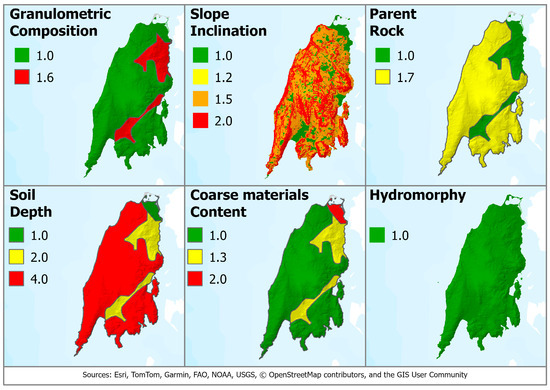
Figure 14.
Spatial distribution of factors used to evaluate the Soil Quality Index (SQI).
The parent material is of medium quality, composed mainly of Tertiary and Quaternary calcareous pebble deposits (assigned value: 1.7). In contrast, soil depth is classified as very shallow, which limits root development and increases vulnerability to degradation (value: 4).
Regarding coarse material content, the soils are notably rocky, which improves drainage and structural resilience (value: 1). Hydromorphic conditions are also favorable, as the soils are generally well drained, reducing the risk of waterlogging and further erosion.
4.4.2. The Climate Quality Index (CQI)
The Climate Quality Index (CQI) evaluates the influence of climatic conditions on land degradation and vegetation potential. It is calculated as the geometric mean of three key parameters: annual precipitation, aridity index, and slope orientation. The formula used is:
CQI = (Precipitation × Aridity index × Slope aspect)^(1/3)
Each parameter captures a distinct climatic factor that contributes to land vulnerability. The geometric mean provides a balanced aggregation of the inputs, reducing the impact of any extreme values.
Based on the resulting CQI score, land is classified into three categories:
- High quality: CQI ≤ 1.15;
- Medium quality: 1.15 < CQI < 1.38;
- Low quality: CQI ≥ 1.38.
In the case of Lefkas Island (Table 5, Figure 15), most areas receive annual precipitation above 650 mm, which supports vegetation growth and minimizes erosion risk. These zones are assigned a precipitation index value of 1. The aridity index, calculated using the Bagnouls–Gaussen method, reflects moderate drought stress, with values of 1.4 and 1.8, indicating a relatively dry but not extreme climate.

Table 5.
Parameter ranking used to obtain the CQI [44].
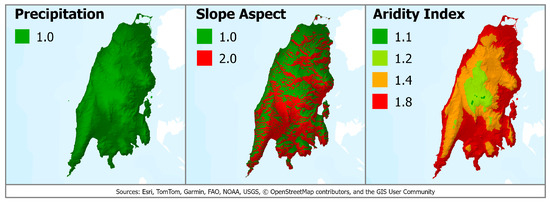
Figure 15.
Spatial distribution of factors used to evaluate the Climate Quality Index (CQI).
Slope orientation also plays a role in microclimatic variation. North-facing slopes, which are less exposed to direct sunlight and evaporation, dominate the northern part of the island and are assigned a value of 1. In contrast, south-facing slopes, which receive more sunlight and are more susceptible to drying and erosion, are prevalent in the southern regions, receiving a value of 2.
Taken together, these parameters suggest that Lefkas Island exhibits a mix of moderate and low climate quality, primarily due to its drier southern areas and sun-exposed slope aspects, which increase vulnerability to degradation.
4.4.3. The Vegetation Quality Index (VQI)
The Vegetation Quality Index (VQI) evaluates how well the vegetation of an area contributes to land stability and resilience against degradation. It is calculated as the geometric mean of four vegetation-related factors: fire risk, erosion protection, drought tolerance, and vegetation cover. The formula used is:
VQI = (Fire Risk × Protection against Erosion × Drought Tolerance × Vegetation Rate)^(1/4)
Each of these parameters reflects an important role that vegetation plays in maintaining ecological balance and protecting the land from erosion and climate stress. The use of the geometric mean ensures that no single factor dominates the index and helps reduce the effect of any extreme values.
Based on the VQI score, vegetation quality is categorized as:
- High quality: SQI ≤ 1.13;
- Medium quality: 1.13 < SQI < 1.45;
- Low quality: SQI ≥ 1.45.
For Lefkas Island (Table 6 and Table 7; Figure 16), the vegetation rate is generally high, earning a value of 1, which indicates good ground coverage. The drought tolerance of plant species is also favorable, with values between 1.2 and 1.4, suggesting that vegetation can withstand moderately dry conditions. In terms of protection against erosion, values range from 1.3 to 1.6, reflecting the ability of the island’s vegetation to reduce soil loss on slopes and disturbed ground.

Table 6.
Land-use classification according to each factor [44].

Table 7.
Parameter ranking used to obtain the VQI [44].
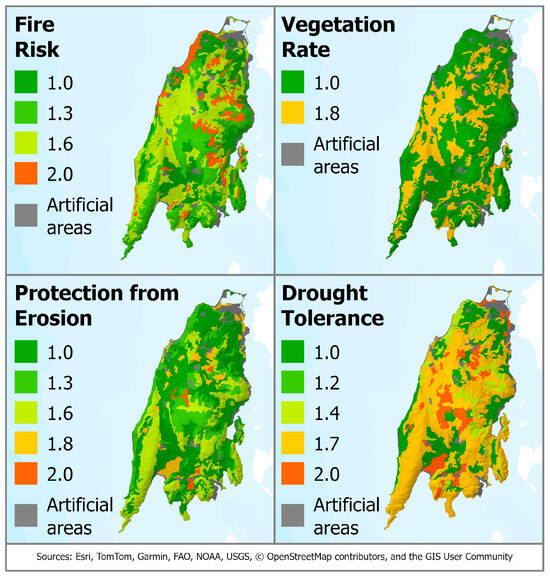
Figure 16.
Spatial distribution of factors used to evaluate the Vegetation Quality Index (VQI).
Taken together, these indicators show that much of Lefkas Island has moderate vegetation quality, with several areas showing traits of higher resilience, particularly in well-vegetated zones. However, some locations with more exposed or degraded vegetation cover may require closer monitoring and targeted conservation measures.
4.4.4. The Management Quality Index (MQI)
The Management Quality Index (MQI) evaluates how human activities and policy implementation affect land stability and the risk of soil degradation. It is calculated as the geometric mean of two parameters: land-use intensity and the level of environmental protection policies related to soil conservation. The formula used is:
MQI = (Land-Use Intensity × Environmental Protection Policy)^(1/2)
These two factors reflect how land is being used and whether effective policies are in place to prevent erosion and promote sustainable management. The use of the geometric mean ensures a balanced combination of both components, reducing the effect of any extreme value.
Based on the resulting MQI value, land is classified into three categories:
- High management quality: MQI ≤ 1.25;
- Medium management quality: 1.25 < MQI < 1.5;
- Low management quality: MQI ≥ 1.5.
On Lefkas Island (Table 8 and Table 9; Figure 17), land-use intensity is generally moderate, with an assigned value of 1.5, suggesting that human activity is present but not excessive—neither highly urbanized nor heavily exploited. In parallel, the implementation of environmental protection policies across most of the island is rated as high (value: 1), indicating that soil conservation measures and sustainable practices are widely adopted.

Table 8.
Land-use classification and ranking used to obtain the ΜQI [44].

Table 9.
Parameter ranking used to obtain the ΜQI [44].
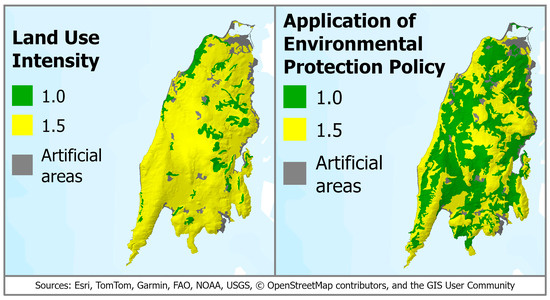
Figure 17.
Spatial distribution of factors used to evaluate the Management Quality Index (MQI).
These conditions place the island’s management quality in the moderate range overall, with some areas showing room for improvement through better land-use planning or stronger enforcement of environmental regulations.
Overall, Lefkas Island displays a varied landscape quality profile when evaluated through the Soil (SQI), Vegetation (VQI), Climate (CQI), and Management (MQI) indices. Soil quality is generally low, mainly due to steep slopes and shallow soil depth, despite favorable factors such as good granulometric composition and coarse material content. Vegetation quality is moderate, supported by high vegetation cover and good drought tolerance, although fire risk remains a concern in certain areas. Climatic conditions are moderately favorable, with adequate precipitation and diverse slope orientations, but the island is also affected by a relatively high aridity index, particularly in the southern regions. Management quality is also rated as moderate, with the widespread implementation of environmental policies helping to balance the effects of moderate land-use intensity.
Bringing together the results of these four individual indices, the Environmentally Sensitive Areas Index (ESAI) provides an overall assessment of land vulnerability to desertification. It is calculated as the geometric mean of the Soil Quality Index (SQI), the Climate Quality Index (CQI), the Vegetation Quality Index (VQI), and the Management Quality Index (MQI), using the formula:
ESAI = (SQI × CQI × VQI × MQI)^(1/4)
The geometric mean was applied to combine the four sub-indices, following the original MEDALUS framework [31]. This method ensures that each component has an equal influence on the final ESAI value, preventing any single variable from disproportionately affecting the result.
Based on the ESAI value, land areas are classified as:
- Not Threatened (N): ESAI < 1.17;
- Potentially Sensitive (P): 1.17–1.22;
- Sensitive (F1–F3): 1.23–1.37;
- Critical (C1–C3): ESAI > 1.38.
When applied to Lefkas Island (Figure 18), the ESAI shows that large portions of the island fall within the sensitive and critical categories. This outcome reflects the combined effects of shallow soils, steep terrain, moderate aridity, and human pressures. Although the island benefits from strengths such as dense vegetation cover and active environmental policy implementation, these positive factors are not sufficient to offset the underlying vulnerabilities—particularly in the southern and mountainous zones, where the risk of land degradation remains high.
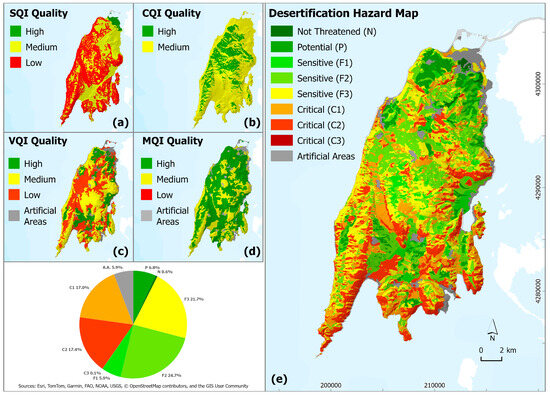
Figure 18.
Desertification Hazard Map of Lefkas Island. The main map (e) presents the ESAI classification, while the smaller inset maps (a–d) depict the spatial distribution of the contributing indices (SQI, CQI, VQI, and MQI). The ESAI assessment reveals that a significant portion of the island—approximately 34.5%—is already degraded, falling into the critical (C1, C2, and C3) categories, primarily in the southern and eastern regions. Nearly 52.3% of the island is classified as sensitive (F1, F2, and F3), indicating areas highly susceptible to further degradation if current land management practices continue. Only a small area (0.6%) is identified as Not Threatened (N), reflecting limited zones of ecological stability. Additionally, Artificial Areas, mainly urbanized zones, account for a notable share of the island’s surface.
4.5. Multi-Hazard Assessment
Studies on multi-hazard assessment report challenges related to the integration of diverse hazard types [45,46,47,48,49,50,51]. A major difficulty lies in combining hazards that differ in nature, measurement units, spatial and temporal scales, and intensity expression. The literature also reflects the lack of a unified methodological framework, with various definitions and analytical approaches used across studies. Three main methods for assessing hazard intensity are commonly identified: (1) hazard matrices, using color-coded classification schemes; (2) hazard indices, which aggregate multiple indicators into a single score; and (3) hazard curves, presenting exceedance probabilities for a given intensity over a defined time period. Despite these structured approaches, authors emphasize the difficulties in applying them, largely due to the limited availability of consistent and reliable hazard data.
Considering these challenges and the available data and scope of this study, we adopted a simplified and transparent approach by calculating the arithmetic mean of the standardized hazard values (flood, landslide, wildfire, and desertification) at each location. This method aligns with internationally recognized practices for constructing composite indices, as outlined by the OECD (2008) [24], which identifies linear aggregation of normalized indicators—such as the arithmetic mean—as a widely accepted and interpretable technique, particularly when there is no clear basis for differential weighting. Although this approach does not account for potential interactions or cascading effects between hazards, it provides a practical means for generating a first-level synthesis of cumulative hazard intensity across the study area.
The resulting Multi-Hazard Map (Figure 19) illustrates the spatial distribution of cumulative hazard intensity across Lefkas Island. According to the analysis, the Medium and high-hazard categories dominate, covering more than 63% of the island’s area. These zones are primarily concentrated in the central and southern regions, where terrain complexity, vegetation, and land-use patterns increase susceptibility to multiple geohazards. In contrast, low- and very-low-hazard areas account for 14.7% and 12.8%, respectively, while very-high-hazard zones cover only 9.1% of the island.
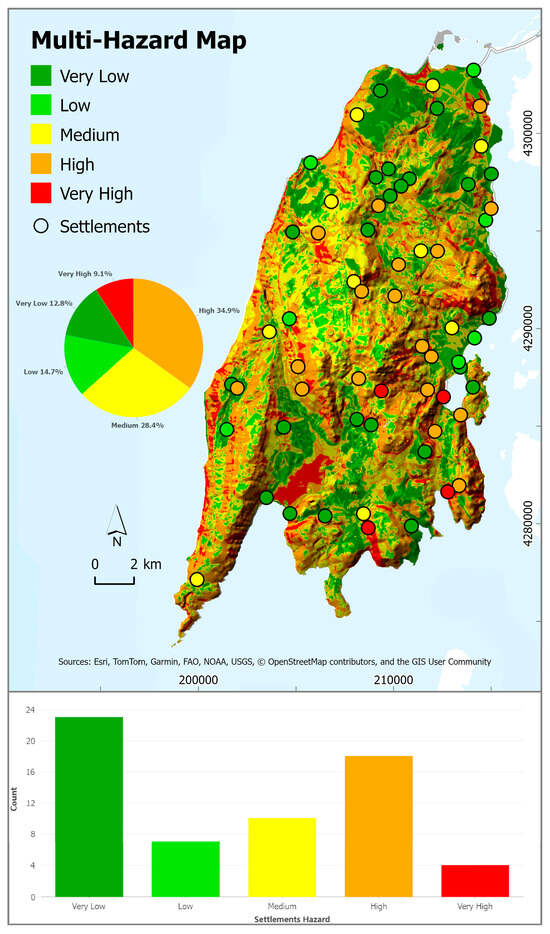
Figure 19.
Multi-Hazard Map of Lefkas Island, integrating flood, landslide, wildfire, and desertification hazards. The map illustrates the spatial distribution of hazard intensity across the island and highlights the exposure of settlements to overlapping geohazards.
The analysis also reveals a clear spatial relationship between hazard intensity and settlement distribution. A considerable number of settlements fall within the medium- to high-hazard zones, highlighting their increased exposure to overlapping risks. This pattern underscores the importance of integrating hazard data into land-use planning, infrastructure development, and emergency preparedness efforts. The map provides a valuable foundation for regional risk management and can support both local authorities and civil protection agencies in prioritizing actions and raising public awareness.
5. Hazard Explorer GIS Application
To complement the hazard analysis presented earlier and to promote public awareness of the multiple natural hazards affecting Lefkas Island—a popular tourist destination—a web-based application was developed, titled Lefkas Island Hazard Explorer. The application is freely accessible at https://arcg.is/0XWX1G (accessed on 5 July 2025) and aims to inform both residents and visitors about various geohazards beyond the well-known seismic risk. Through interactive maps and accessible information, the app functions as an educational and awareness tool that encourages community preparedness and safety.
Unlike expert-focused platforms—such as that of Albamonte et al. (2025) [42], which integrates satellite data, contextual information, and advanced semantic techniques for glacier monitoring—this application is designed for a general audience. It prioritizes simplicity, accessibility, and ease of use, offering clear hazard visualizations and basic guidance rather than advanced geospatial analysis or remote sensing interpretation.
The application was developed using ArcGIS Experience Builder [25], chosen for its flexible layout and ability to integrate dynamic content and interactive mapping. The platform supports intuitive design and is suitable for users with varied levels of technical experience.
The Lefkas Island Hazard Explorer consists of several core components:
- Home Page;
- Four hazard-specific pages (flood, landslide, wildfire, and desertification);
- Two additional pages: “How to Use” and “Explore Maps”;
- Nine fixed informational windows, including a disclaimer, four hazard explanation panels, and four contact windows linking to relevant authorities.
Home Page: The Home Page (Figure 20) provides a visual overview of Lefkas Island and buttons to navigate to the “How to Use” and “Explore Maps” pages. Sharing options, a QR code generator, and an embed link are also available. Upon first access, users are required to accept a disclaimer that clarifies the academic and informational nature of the app. It emphasizes that the application is not an official hazard warning or emergency response tool and should not replace advisories issued by government agencies.

Figure 20.
Screenshot showing the Home Page of the Lefkas Island Hazard Explorer. Users can select to see information about the web app or directly explore the hazard maps. Options to share the app are also available.
How to Use Page: This page offers a concise explanation of the app’s purpose, intended audience, and instructions on how to use its features. It helps ensure that users—regardless of familiarity with GIS—can explore the content with ease.
Explore Maps Page: The “Explore Maps” page acts as a gateway to the four hazard-specific maps. Each hazard is represented by an image tile; clicking one leads to the corresponding hazard page facilitating easy access to specific hazard information (Figure 21).
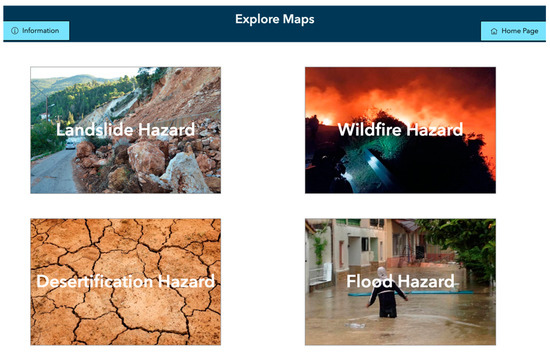
Figure 21.
Screenshot showing the Home Page of the Lefkas Island Hazard Explorer. Users can select to see inform.
Hazard Pages: Each of the four hazard pages includes a map pane and a side panel (Figure 22). In the map pane, a map shows the spatial distribution of the hazard using the 25 m resolution, while a pie chart summarizing the percentage of the area covered by each hazard category. Tools for zooming, panning, changing basemaps, and toggling data layer are present. In the side panel, descriptive text is explaining the methodology, key map features, and the location of high/low-risk zones. Navigation buttons to switch between hazard pages, return to the Home Page, or access general hazard information followed by links to official organizations are present at the top.
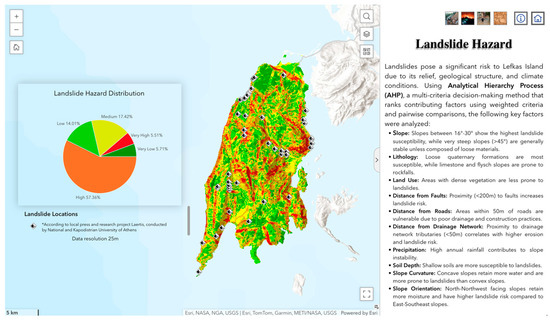
Figure 22.
Screenshot showing a hazard page example of the Lefkada Hazard Explorer. Users can zoom in or out, pan, search for a specific location, change basemap, or toggle on-off different layers of information. They can also read the narration provided about hazard analysis and findings. The navigation panel at the upper left provides access to the other hazards and Home Page, while the info button directs to general information about the specific hazard, followed by links to the main official organizations dealing with this hazard.
The application features a simple and intuitive navigation design, with clearly labeled buttons that make it easy for users to move between pages. From the Home page, users can directly access the “How to Use” and “Explore Maps” sections. The “Explore Maps” page presents clickable images representing each hazard, allowing users to quickly view detailed maps and related information. Each hazard-specific page includes a consistent set of navigation tools that let users switch between hazards, return to the Home Page, or access additional hazard-related resources (Figure 20, Figure 21 and Figure 22). Informational pop-up windows provide external links that open in a new tab, and users can close these windows by clicking anywhere outside them. The app maintains a consistent visual design across all pages—using the same images and button styles—ensuring clarity, familiarity, and a smooth user experience.
The web application is still in the early stages of public release, and user feedback and usage statistics are not yet available. However, it includes integrated analytics capabilities to record user interactions, which will be activated during the upcoming dissemination phase to support usability evaluation and future enhancements.
6. Discussion
This study presented a comprehensive GIS-based assessment of major natural hazards affecting Lefkas Island, including flooding, landslides, wildfires, and desertification. While seismic activity is known to dominate the region’s geohazard profile, our findings highlight that other hazards—particularly landslides and desertification—pose equally critical threats to both ecosystems and communities.
Flood-prone zones were concentrated in low-elevation, populated areas, underscoring the importance of targeted flood mitigation strategies such as improved drainage infrastructure, river channel maintenance, and informed land-use planning. Landslide susceptibility analysis revealed medium- to high-hazard zones, accounting for 74.7% of the island’s area. These zones are mainly concentrated in the central region and along both the western and eastern coastal areas, highlighting the need for slope stabilization measures and hazard-informed spatial planning. Similarly, Wildfire hazard assessment shows that a significant portion of the island falls within the high- to very-high-hazard classes, emphasizing the urgent need for comprehensive fire management strategies, including vegetation control, firebreak construction, and continuous monitoring. Desertification analysis further indicates that 86.8% of the island is classified as either sensitive or critical, particularly affecting the southern and eastern regions. This finding highlights the importance of adopting sustainable land management practices to mitigate long-term environmental degradation.
The Multi-Hazard Map provides a first-level synthesis of cumulative hazard exposure, showing that over 63% of Lefkas Island is exposed to medium- to high-cumulative-hazard levels. This reinforces the need for integrated risk mitigation strategies, particularly in central and southern regions where multiple hazards overlap. However, the map does not currently account for dynamic interactions or cascading effects between hazards (e.g., wildfire increasing landslide susceptibility). This simplification reflects existing data constraints and this study’s scope. Future research should explore hybrid modeling approaches that integrate physically based and data-driven components within a GIS environment to better capture such interdependencies.
Furthermore, future work should prioritize the integration of real-time and temporally dynamic datasets to improve hazard prediction and monitoring. The incorporation of satellite-derived time-series data, such as the NDVI and other vegetation or moisture indices, will help detect changes in land condition and better assess wildfire and desertification dynamics. Similarly, the use of detailed precipitation metrics—including rainfall intensity–duration thresholds and prior rainfall conditions—can significantly improve the modeling of rainfall-triggered landslides.
To address uncertainties in key environmental variables, future research should also consider probabilistic modeling frameworks that enhance the robustness of hazard assessments. Additionally, for composite indices such as the ESAI, alternative integration schemes—like weighted additive models or data-driven techniques such as Principal Component Analysis (PCA)—should be tested to evaluate the sensitivity of final classifications. The incorporation of seismic-related parameters—such as peak ground acceleration (PGA) or scenario-based shaking maps—is also essential, particularly in refining landslide and multi-hazard models for tectonically active regions like Lefkas.
A key outcome of this research is the demonstrated value of integrating local knowledge and community awareness into disaster risk management strategies. While past experiences have made residents aware of local hazards, fostering long-term resilience requires continuous education and proactive engagement. The GIS-based web application developed in this study provides an interactive platform for increasing public awareness, supporting educational initiatives, and facilitating access to hazard-related information.
7. Conclusions
This study highlights the value of GIS-based multi-hazard assessment for informing land-use planning and disaster risk management on Lefkas Island. While seismic hazards remain dominant in the region’s risk profile, our findings show that floods, landslides, wildfires, and desertification also represent significant threats. Over 63% of the island falls into medium to high-cumulative-hazard zones, with landslide and desertification risks affecting the largest extents.
The development of a GIS-based web application represents a key contribution, enabling interactive access to hazard information for both residents and visitors. Although the platform currently serves as a public awareness tool, it has the potential to support broader educational and decision-making processes.
Future efforts should focus on improving hazard models by incorporating dynamic datasets, interaction modeling, and demographic overlays. Expanding the web application with mobile access and usage tracking will also strengthen its impact. Ultimately, stronger collaboration between researchers, local authorities, and communities will be essential to building an adaptive and resilient framework for addressing Lefkas Island’s evolving natural hazards.
Supplementary Materials
The following supporting information can be downloaded at: https://www.mdpi.com/article/10.3390/app15147935/s1, Table S1. Summary of spatial datasets used in the analysis. The table includes dataset names, sources, spatial resolution, preprocessing notes (where applicable), and the corresponding hazard assessment in which each dataset was used.
Author Contributions
Conceptualization, V.A.; methodology, E.K. and V.A.; software, E.K. and V.A.; validation, V.A.; formal analysis, E.K.; investigation, E.K. and V.A.; resources, E.K. and V.A.; data curation, V.A.; writing—original draft preparation, E.K. and V.A.; writing—review and editing, V.A. and E.K.; visualization, V.A.; supervision, V.A.; project administration, E.K. All authors have read and agreed to the published version of the manuscript.
Funding
This research received no external funding.
Institutional Review Board Statement
Not applicable.
Informed Consent Statement
Not applicable.
Data Availability Statement
A summary table listing all spatial datasets used in the analysis, along with their sources, resolution, availability, and the type of hazard assessment they supported, is provided in the Supplementary Materials (Table S1). Most datasets used in this study are publicly available through national or European data repositories, as indicated in the table. However, a small number of datasets derived from third-party collaborations or field observations are not publicly available due to data-sharing restrictions and privacy agreements. These datasets may be made available upon reasonable request to the corresponding author, subject to permission from the data providers.
Acknowledgments
The authors would like to thank the LAERTIS project for providing access to the landslide occurrence data used in this study.
Conflicts of Interest
The authors declare no conflicts of interest.
References
- United Nations Office for Disaster Risk Reduction (UNDRR). Sendai Framework for Disaster Risk Reduction 2015–2030. 2015. Available online: https://www.undrr.org/publication/sendai-framework-disaster-risk-reduction-2015-2030 (accessed on 15 July 2025).
- Kelman, I.; Gaillard, J.C. Disaster Risk Reduction: Integrating People, Science and Policy; Routledge: Oxfordshire, UK, 2017. [Google Scholar]
- Adger, W.N. Vulnerability. Glob. Environ. Chang. 2006, 16, 268–281. [Google Scholar] [CrossRef]
- Goodchild, M.; Haining, R. GIS and Spatial Data Analysis: Converging Perspectives. Rev. Econ. Des. 2003, 83, 363–385. [Google Scholar] [CrossRef]
- Friedrich, M.; Aubrecht, C. Geographic Information Systems (GIS) for disaster management and spatial planning. In Handbook of Disaster Research, 2nd ed.; Rodríguez, H., Donner, W., Trainor, J.E., Eds.; Springer: Berlin/Heidelberg, Germany, 2021; pp. 251–269. [Google Scholar] [CrossRef]
- ESRI. GIS for Disaster Response and Recovery. 2021. Available online: https://www.esri.com/en-us/disaster-response/overview (accessed on 5 July 2025).
- FEMA. Hazus Flood Maps and Tools; Federal Emergency Management Agency: Washington, DC, USA. Available online: https://www.fema.gov/flood-maps/products-tools/hazus (accessed on 5 July 2025).
- Copernicus Emergency Management Service. Emergency Mapping. Available online: https://emergency.copernicus.eu/ (accessed on 5 July 2025).
- Bodzin, A.M.; Fuhrmann, S. Exploring the use of GIS in disaster management and emergency response. In Handbook of Research on Geoinformatics; IGI Global: Hershey, PA, USA, 2013; pp. 446–467. [Google Scholar]
- Meier, P. Crisis Mapping and the Future of Humanitarian Response; Routledge: Oxfordshire, UK, 2015. [Google Scholar]
- Nikolakopoulos, K.; Kyriou, A.; Koukouvelas, I.; Zygouri, V.; Apostolopoulos, D. Combination of Aerial, Satellite, and UAV Photogrammetry for Mapping the Diachronic Coastline Evolution: The Case of Lefkada Island. ISPRS Int. J. Geo-Inf. 2019, 8, 489. [Google Scholar] [CrossRef]
- Sikdar, P.; Chakraborty, S.; Adhya, E.; Paul, P. Land use/land cover changes and groundwater potential zoning in and around Raniganj coal mining area, Bardhaman District, West Bengal—A GIS and remote sensing approach. J. Spat. Hydrol. 2004, 4, 1–24. [Google Scholar]
- Stournaras, G.; Yoxas, G.; Vassilakis, E.; Nastos, P. Climate Change Implications on Groundwater in Hellenic Region; Springer: Berlin/Heidelberg, Germany, 2011; pp. 91–98. [Google Scholar] [CrossRef]
- Ministry of Agriculture. Map of Bioclimatic conditions. 1978. Available online: https://www.geogreece.gr/bioclima_en.php (accessed on 5 July 2025).
- Konidari, A.; SIA OE. Environmental Impact Study: Construction of a slipway with a hauling-up and launching ramp for vessels at the Konidar Shipyard. 2022. Available online: https://pin.gov.gr/wp-content/uploads/2022/09/%CE%9C%CE%A0%CE%95_15.07.2022_signed-BOTH2.pdf (accessed on 5 July 2025). (In Greek)
- Bornovas, I.M. Géologie de l’île de Lefkade. Geology–Geophysics Research; Special Publication No. 10; Greek Geological Survey: Attika, Greece, 1964. [Google Scholar]
- Lazokitsiou, V. The Geological Structure of the Wider Area of Agios Elias Lefkada. 2016.
- Bathrellos, G.; Antoniou, V.; Skilodimou, H. Morphotectonic characteristics of Lefkas Island during the Quaternary (Ionian Sea, Greece). Geol. Balc. 2009, 38, 23–33. [Google Scholar] [CrossRef]
- IGME. Geological Map of the Lefkada Island (1:50,000); Institute for Geological and Mineral Exploration: Athens, Greece, 1963. [Google Scholar]
- Esri. ArcGIS Pro—Overview. Available online: https://www.esri.com/en-us/arcgis/products/arcgis-pro/overview (accessed on 15 July 2018).
- Saaty, T.L. The Analytic Hierarchy Process: Planning, Priority Setting, Resource Allocation; McGraw-Hill: New York, NY, USA, 1980. [Google Scholar]
- Papanikolaou, D.; Papanikolaou, I.; Deligiannakis, G. Forest Cities—Guide for Drafting an Action Plan for the Prevention of Forest Fires; Life08 ENV/GR/000553; Laboratory of Prevention and Management of Natural Disasters, National and Kapodistrian University of Athens: Athens, Greece, 2012; Available online: https://webgate.ec.europa.eu/life/publicWebsite/project/LIFE08-ENV-GR-000553/local-authorities-alliance-for-forest-fire-prevention (accessed on 5 July 2025). (In Greek)
- European Commission. Mediterranean Desertification and Land Use: Manual on Key Indicators of Desertification and Mapping Environmentally Sensitive Areas to Desertification. 1999. Available online: https://op.europa.eu/en/publication-detail/-/publication/73f845d2-9043-48bb-837e-61df0f34a642 (accessed on 5 May 2024).
- Organisation For Economic Co-Operation And Development. Handbook on Constructing Composite Indicators: Methodology and User Guide; JRC European Commission, OECD Publishing: Paris, France, 2008. [Google Scholar]
- Esri. ArcGIS Experience Builder—Overview. Available online: https://www.esri.com/en-us/arcgis/products/arcgis-experience-builder/overview (accessed on 5 July 2025).
- Esri. ArcGIS Online. Available online: https://www.arcgis.com/index.html (accessed on 5 July 2025).
- Ministry of Environment and Energy (Greece). Floods—Water Resources. Available online: https://ypen.gov.gr/perivallon/ydatikoi-poroi/plimmyres/ (accessed on 5 July 2025).
- Lefkada Press. 2022. Available online: https://lefkadapress.gr (accessed on 5 July 2025).
- NKUA. Laertis—Innovative Operational System for Natural Hazards Management in the Ionian Islands Region; Research Project; Department of Geology and Geoenvironment, National and Kapodistrian University of Athens: Athens, Greece, 2023. (In Greek) [Google Scholar]
- Saroglou, C.; Asteriou, P.; Zekkos, D.; Tsiambaos, G.; Clark, M.; Manousakis, J. UAV-based mapping, back analysis and trajectory modeling of a coseismic rockfall in Lefkada island, Greece. Nat. Hazards Earth Syst. Sci. 2018, 18, 321–333. [Google Scholar] [CrossRef]
- Kosmas, C.; Kirkby, M.; Geeson, N. The Medalus Project: Mediterranean Desertification and Land Use. Manual on Key Indicators of Desertification and Mapping Environmentally Sensitive Areas to Desertification. 1999. Available online: https://catalogue.unccd.int/629_Medalus_ESA_%20Manual.pdf (accessed on 5 July 2025).
- Bliona, M. Development of a Landslide Database in the Greek Territory. Doctoral Dissertation, University of Patras Repository, Patras, Greece, 2008. (In Greek). [Google Scholar]
- Rozos, D. Englineering Geology Handbook I; National Technical University of Athens, School of Mining and Metallurgical Engineering, Department of Geological Sciences, Laboratory of Engineering Geology and Hydrogeology: Athens, Greece, 2009; 32p. (In Greek) [Google Scholar]
- Guzzetti, F.; Peruccacci, S.; Rossi, M.; Stark, C. The rainfall intensity-duration control of shallow landslides and debris flows: An update. Landslides 2008, 5, 3–17. [Google Scholar] [CrossRef]
- Papathanassiou, G.; Valkaniotis, S.; Chatzipetros, A.; Pavlides, S. Liquefaction susceptibility map of Greece. Bull. Geol. Soc. Greece 2010, 43, 1383–1392. [Google Scholar] [CrossRef]
- Ambas, V.; Katsaros, E.; Alexoudi, M.; Olasoglou, E.; Tsapanos, T.; Koravos, G.; Drakatos, G.; Tzamos, E. Landslides in Vitsi (Florina) Territory. Bull. Geol. Soc. Greece 2016, 50, 577–585. [Google Scholar] [CrossRef]
- Tsagkari, G.; Karetsos, G.; Proutsos, N. Greece’s Forest Fires 1983–2008; Forest Research Institute, Greek Ministry of Environment: Athens, Greece, 2011; 186p. (In Greek) [Google Scholar]
- National Observatory of Athens. DIAchronic BSM Platform. Available online: http://ocean.space.noa.gr/diachronic_bsm/index.php (accessed on 5 July 2025).
- Golden Gate National Recreation Area Fire Management Plan FEIS. Available online: https://parkplanning.nps.gov/document.cfm?documentID=13599 (accessed on 5 July 2025).
- United Nations Convention to Combat Desertification (UNCCD). UNCCDConvention Text, 3rd ed.; UNCCD: Bonn, Germany, 2012; Available online: https://catalogue.unccd.int/936_UNCCD_Convention_ENG.pdf (accessed on 22 March 2025).
- Sartor, G.; Salis, M.; Pinardi, S.; Saracik, Ö.; Meo, R. Deep learning tools to support deforestation monitoring in the Ivory Coast using SAR and optical satellite imagery. arXiv 2024, arXiv:2409.11186. [Google Scholar] [CrossRef]
- Albamonte, G.; Falcone, G.; Senatore, S. Remote glacier monitoring through semantic fusion of geographic and contextual data. Eng. Appl. Artif. Intell. 2025, 129, 111366. [Google Scholar] [CrossRef]
- Darnkachatarn, S.; Kajitani, Y. Long-term flood exposure assessment using satellite-based land use change detection and inundation simulation: A 30-year case study of the Bangkok Metropolitan Region. J. Flood Risk Manag. 2024, 17, e12997. [Google Scholar] [CrossRef]
- Karamesouti, M.I. Definition of Environmentally Sensitive Areas of Greece to Desertification; Agricultural University of Athens: Athens, Greece, 2011. [Google Scholar]
- Delmonaco, G.; Margottini, C.; Spizzichino, D. ARMONIA Methodology for Multi-Risk Assessment and the Harmonisation of Different Natural Risk Maps; Deliverable 3.1.1; ARMONIA: Rome, Italy, 2006; Available online: https://www.scribd.com/document/616732009/ARMONIA-PROJECT-Deliverable3-1 (accessed on 5 July 2025).
- Gallina, V.; Torresan, S.; Critto, A.; Sperotto, A.; Glade, T.; Marcomini, A. A review of multi-risk methodologies for natural hazards: Consequences and challenges for a climate change impact assessment. J. Environ. Manag. 2016, 168, 123–132. [Google Scholar] [CrossRef] [PubMed]
- Gentile, R.; Cremen, G.; Galasso, C.; Jenkins, L.T.; Manandhar, V.; Menteşe, E.Y.; Guragain, R.; McCloskey, J. Scoring, selecting, and developing physical impact models for multi-hazard risk assessment. Int. J. Disaster Risk Reduct. 2022, 82, 103365. [Google Scholar] [CrossRef]
- Kappes, M.S.; Keiler, M.; von Elverfeldt, K.; Glade, T. Challenges of analyzing multi-hazard risk: A review. Nat. Hazards 2012, 64, 1925–1958. [Google Scholar] [CrossRef]
- Wood, N.; Pennaz, A.; Marineau, J.; Jones, J.; Jones, J.; Ng, P.; Henry, K. Multi-hazard risk analysis for the US Department of the Interior: An integration of expert elicitation, planning priorities, and geospatial analysis. Int. J. Disaster Risk Reduct. 2022, 82, 103385. [Google Scholar] [CrossRef]
- Zschau, J. Where are we with multihazards, multirisks assessment capacities? In Science for Disaster Risk Management: Knowing Better and Losing Less; Poljansek, K., Marin Ferrer, M., De Groeve, T., Clark, I., Eds.; European Union: Brussels, Belgium, 2017; pp. 98–115. Available online: https://gfzpublic.gfz-potsdam.de/pubman/item/item_3183904 (accessed on 5 July 2025).
- Koudoumakis, P.; Keramitsoglou, K.; Protopapas, A.L.; Dokas, I. A general method for multi–hazard intensity assessment for cultural resources: Implementation in the region of Eastern Macedonia and Thrace, Greece. Int. J. Disaster Risk Reduct. 2023, 92, 104197. [Google Scholar] [CrossRef]
Disclaimer/Publisher’s Note: The statements, opinions and data contained in all publications are solely those of the individual author(s) and contributor(s) and not of MDPI and/or the editor(s). MDPI and/or the editor(s) disclaim responsibility for any injury to people or property resulting from any ideas, methods, instructions or products referred to in the content. |
© 2025 by the authors. Licensee MDPI, Basel, Switzerland. This article is an open access article distributed under the terms and conditions of the Creative Commons Attribution (CC BY) license (https://creativecommons.org/licenses/by/4.0/).